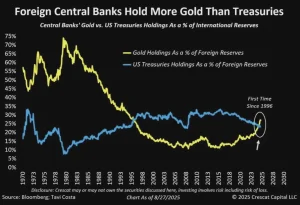For centuries, gold has been a timeless measure of wealth, a constant in a world of shifting economic paradigms. Yet, in modern times, we’ve grown accustomed to viewing our financial world through the lens of the U.S. dollar, treating it as the stable denominator against which all value is measured. But what if we invert this perspective? By measuring wealth in terms of gold (XAU) rather than dollars (USD), a stark reality emerges: the dollar is in a relentless decline, losing value at a rate that demands an 8% annual return just to break even in real terms. This inversion flips our understanding of investment, revealing gold not just as a safe haven but as a benchmark for taking risk.
The Dollar’s Fall Against Gold
On August 15, 1971, when President Nixon severed the dollar’s tie to the gold standard, ending its convertibility at $35 per ounce, the London Bullion Market Association (LBMA) priced gold at approximately $43 per ounce. Today, as of June 13, 2025, gold commands a price of around $3,430 per ounce. This represents a compounded annual growth rate of approximately 8.48% over 53 years when measured in dollars. But this framing—gold’s price in dollars—obscures the deeper truth. It’s not that gold has skyrocketed in value; it’s that the dollar has plummeted.
When we invert the relationship, measuring dollars in terms of gold (USD/XAU), the picture becomes sobering. In 1971, one ounce of gold was worth $43. Today, that same ounce requires $3,430, meaning the dollar has lost approximately 98.7% of its value against gold. Put another way, the dollar’s purchasing power relative to gold is now just 1.25% of what it was in 1971. This translates to an annual loss of about 7.81% when measured against gold’s stability. The dollar, as a fiat currency unshackled from any tangible anchor, has been bleeding value for over half a century.
Gold as the True Denominator
Our economic system encourages us to think in dollars: salaries, investments, and prices are all quoted in USD. But this convention masks the dollar’s erosion. By using gold as the denominator, we see wealth in a new light. An investment that returns less than 8% per year isn’t growing—it’s shrinking in real terms. The 8.48% average annual increase in gold’s dollar price sets a hurdle rate of roughly 8% for any investment to maintain its purchasing power against this enduring asset. Stocks, bonds, or real estate must clear this bar to deliver a true return on capital when measured against gold’s steadfast value.
Consider this: in 1971, $43 could buy an ounce of gold. Today, that same ounce requires $3,430. If you had invested $43 in 1971 in something yielding less than 8.48% annually, your wealth, when measured in gold, would have diminished. A dollar-based mindset might fool you into thinking a 5% return is a gain, but in gold terms, it’s a loss. This inversion forces us to confront the reality that fiat currencies, like the dollar, are not stable stores of value. Gold, by contrast, has held its ground, outpacing inflation by approximately 910% since 1971.
Gold as the Denominator: USD/XAU Value Relationship
To understand the declining value of the U.S. dollar (USD) when measured against gold (XAU), we can invert the traditional perspective of quoting gold’s price in dollars. Instead of asking how many dollars one ounce of gold is worth, we calculate how many ounces of gold one dollar can buy (XAU/USD). This table illustrates the USD/XAU relationship across historical and projected gold prices, highlighting the dollar’s diminishing purchasing power relative to gold.
| Year | Gold Price (USD per oz) | USD/XAU (oz per USD) |
|---|---|---|
| 1971 | $43 | 0.02222 |
| 2000 | $279 | 0.00358 |
| 2005 | $444 | 0.00225 |
| 2010 | $1,224 | 0.00020 |
| 2020 | $1,769 | 0.00056 |
| 2025 | $3,430 | 0.00029 |
| 2030 | $5,150 | 0.00019 |
| 2035 | $9,443 | 0.00010 |
| 2040 | $15,678 | 0.00006 |
Explanation
- Gold Price (USD per oz): The price of one ounce of gold in USD at the specified time or hypothetical value.
- USD/XAU (oz per USD): Calculated as 1 ÷ (Gold Price in USD). This shows how many ounces of gold one dollar can buy, reflecting the dollar’s purchasing power.
- Dollar Value Loss (%): The percentage decline in the dollar’s value relative to gold since 1971, calculated as (1 – (USD/XAU ÷ 0.02326)) × 100.
- Notes: Contextual details, including historical data, current price, and projections based on an 8.48% compound annual growth rate.
This table underscores that as gold’s dollar price rises, the dollar’s value in gold terms falls dramatically. In 1971, one dollar could buy 0.02326 ounces of gold. By 2025, it buys only 0.00029 ounces, and by 2029, it may buy just 0.00019 ounces. This inversion reveals an 8% hurdle rate for investments: to preserve wealth in gold terms, an investment must return at least 8% annually to match gold’s historical 8.48% compound rate, as anything less results in a real loss of purchasing power.
The Future: Gold’s Trajectory and the Dollar’s Descent
If gold continues its historical compounding rate of 8.48% for another five years, its dollar price could reach approximately $5,150.00 per ounce by 2029, calculated as ((1.0848^5) × $3,430.00) = $5,151.84. This projection assumes the dollar continues its decline relative to gold. If current trends hold, the dollar’s value against gold could fall to just 0.83% of its 1971 level, a staggering 99.17% loss. At that point, $5,150.00 would buy what $43.00 did in 1971—one ounce of gold—illustrating the dollar’s march toward irrelevance.
Moreover, if gold’s outperformance of inflation persists, it could beat inflation by roughly 1,153% over the next five years. This isn’t just a statistical curiosity; it’s a wake-up call. The dollar, like all fiat currencies before it, risks fading into the “dustbin of history,” as critics of fiat systems often warn. History is littered with examples of paper currencies—unbacked by tangible assets—that collapsed under the weight of overprinting and mismanagement. The Roman denarius, the French assignat, and the Weimar mark all met similar fates. The dollar, while dominant today, is not immune to this cycle.
Rethinking Wealth Preservation
This inverted perspective—measuring wealth in gold rather than dollars—challenges conventional financial wisdom. It suggests that investors must aim for at least an 8% annual return to preserve their capital’s real value. Anything less, and they’re losing ground, not just against inflation but against the enduring yardstick of gold. This has profound implications for portfolio construction. Stocks may offer growth, but their volatility requires careful selection to consistently clear the 8% hurdle. Bonds, with yields often below this threshold, may preserve nominal value but erode real wealth. Real estate, while tangible, is subject to market cycles and local risks. Gold, by contrast, offers simplicity and resilience, a hedge against the dollar’s inevitable decline.
The thought experiment of using gold as the denominator also raises deeper questions about our economic system. Why do we measure wealth in a currency that loses value by design? Central banks, through monetary policy, target inflation rates that erode purchasing power, effectively taxing savers. Gold, free from such manipulation, exposes this flaw. It’s not a perfect asset—its price can be volatile in the short term, and it generates no income—but its long-term stability forces us to question the dollar’s role as the default measure of value.
Gold as a Hurdle Rate to Investment
For investors, the lesson is clear: an 8% hurdle rate is the minimum for any investment to maintain its worth in gold terms. This doesn’t mean abandoning all other assets for gold bars, but it does mean recognizing gold’s role as a benchmark and a hedge. A diversified portfolio might include equities for growth, bonds for income, and gold for stability, but the returns must collectively surpass 8% to outpace the dollar’s decline. Gold’s historical performance—compounding at 8.48% and beating inflation by 910%—makes it a cornerstone for wealth preservation.
As the dollar continues its slide, potentially losing another 0.42% of its gold-based value by 2029, investors must rethink their approach. The USD/XAU inversion isn’t just a mathematical exercise; it’s a paradigm shift. By measuring wealth in gold, we see the fragility of fiat and the enduring strength of a metal that has held value for millennia. In a world of economic uncertainty, gold remains a golden yardstick, reminding us that true wealth is measured not in dollars, but in what those dollars can buy.





Be First to Comment